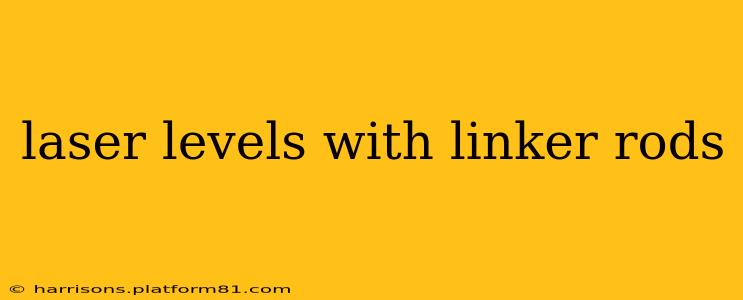Laser levels are indispensable tools for various tasks, from simple DIY projects to large-scale construction. While standard laser levels offer precision, their range and application can be limited. This is where laser levels with linker rods come into play, significantly expanding their capabilities and accuracy. This comprehensive guide explores the benefits, applications, and considerations when choosing a laser level with linker rods.
What are Linker Rods (or Extension Rods)?
Linker rods, also known as extension rods or extension poles, are precisely manufactured rods used to extend the reach of a laser level. These rods typically feature threaded ends that securely connect to the laser level and other components, ensuring stability and maintaining the accuracy of the laser beam. The lengths of these rods vary, allowing for adjustments to suit the project's needs. They are crucial for reaching higher points or spanning wider areas inaccessible to standard laser levels.
How do Laser Levels with Linker Rods Work?
The system is straightforward: the laser level mounts to one end of the linker rod, often using a sturdy mounting bracket. The other end of the rod might attach to a wall mount, tripod, or another stabilizing fixture. The laser beam then projects along the length of the linker rod, accurately transferring the level's reference point to the desired location. The precision of the linker rods is vital, ensuring the laser's accuracy isn't compromised by bending or misalignment.
Benefits of Using Laser Levels with Linker Rods
- Extended Reach: The most significant benefit is the increased range. Reaching high ceilings, spanning long distances, or working on large projects becomes feasible.
- Improved Accuracy: High-quality linker rods maintain the laser's accuracy, minimizing deviation and ensuring precise leveling, even at extended distances.
- Versatility: They adapt to various applications and work environments, catering to both indoor and outdoor projects.
- Enhanced Productivity: By extending reach and improving accuracy, these systems boost efficiency and reduce the time spent on leveling tasks.
- Safety: They often eliminate the need for precarious ladders or scaffolding, improving workplace safety.
What are the Different Types of Linker Rods?
Linker rods are available in various lengths and materials, affecting their weight, durability, and cost. Some common types include:
- Aluminum Linker Rods: These are lightweight, yet sturdy and relatively inexpensive.
- Fiberglass Linker Rods: Offering higher strength and resistance to bending, these are a good choice for demanding jobs.
- Carbon Fiber Linker Rods: The most expensive option, these provide exceptional strength, lightness, and rigidity, making them ideal for professional applications.
The choice of material depends on factors like project size, desired accuracy, and budget.
What Projects Benefit Most from Laser Levels with Linker Rods?
Many applications benefit from the extended range and accuracy provided by these systems. Some examples include:
- Construction: Leveling foundations, setting up framing, installing ceilings, and aligning walls.
- Interior Design: Hanging drywall, installing cabinets, and ensuring level surfaces.
- Land Surveying: Establishing grade, aligning fences, and performing other surveying tasks.
- Plumbing and Electrical Work: Ensuring pipes and wiring run level and plumb.
How to Choose the Right Laser Level with Linker Rods
Choosing the appropriate laser level with linker rods involves considering several factors:
- Laser Type: Different lasers (e.g., rotary, line, point) cater to specific needs.
- Range: Determine the maximum reach required for your projects.
- Accuracy: Look for levels with high accuracy and stable linker rods.
- Durability: Choose a system that can withstand the demands of your work environment.
- Features: Some laser levels offer self-leveling, digital displays, and other features that enhance usability.
How Much Do Laser Levels with Linker Rods Cost?
The cost varies significantly depending on the laser level's quality, the linker rods' length and material, and additional features. Expect to pay more for higher accuracy, extended reach, and robust construction. Budget-friendly options are available for DIY projects, while professional-grade systems are more expensive but justify the investment through their increased precision and durability.
Where Can I Buy a Laser Level with Linker Rods?
Laser levels and linker rods are readily available from various retailers, including online marketplaces like Amazon and specialized construction supply stores. Comparing prices and features from multiple suppliers is recommended to ensure you get the best value.
This guide provides a comprehensive overview of laser levels with linker rods, helping you understand their benefits, applications, and selection process. Remember to choose a system that meets your specific needs and budget, ensuring your projects are completed with the highest level of accuracy and efficiency.
